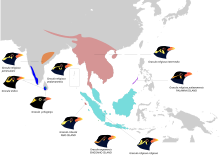Gracula
| Gracula | |
|---|---|
 |
|
| Diversity and distribution within the genus | |
| Scientific classification | |
| Kingdom: | Animalia |
| Phylum: | Chordata |
| Class: | Aves |
| Order: | Passeriformes |
| Family: | Sturnidae |
| Genus: |
Gracula Linnaeus, 1758 |
| Diversity | |
| see text | |
| Synonyms | |
|
|
Gracula is a genus of mynas, tropical members of the starling family of birds found in southern Asia and introduced to Florida, U.S.A.
Until recently only two species were recognised, G. religiosa and G. ptilogenys. Previously, all Gracula were considered to belong to a very variable species commonly called hill myna. Three additional subspecies of G. religiosa are increasingly being considered as distinct species. Formerly, the Sri Lanka hill myna was considered to be a subspecies of the common hill myna, but today all major authorities recognise them as separate. Comparably, the Enggano, Nias and Southern hill mynas have traditionally been treated as subspecies of the common hill myna; a treatment still preferred by some authorities.
Five extant species are recognized:
Formerly, some authorities also considered the following species (or subspecies) as species within the genus Gracula:
These 25–30 cm long birds have glossy black plumage and large white wing patches which are obvious in flight. The bill and strong legs are bright yellow or orange, and there are yellow wattles on the head, the shape and position of which vary with species. The sexes are similar, but juveniles have a duller bill.
Hill mynahs are renowned for their ability to mimic the human voice. It has been claimed that the hill mynah is the best talking bird and the best mimic in the world.
This genus has representatives in tropical southern Asia from India, Bangladesh and Sri Lanka east to Indonesia, and the common hill myna, a popular cage bird, has been introduced to the United States.
The hill mynas are resident breeders typically found in forest and cultivation. The nest is built in a hole and the usual clutch is two or three eggs.
Like most starlings, the hill mynas are fairly omnivorous, eating fruit, nectar and insects.
...
Wikipedia
